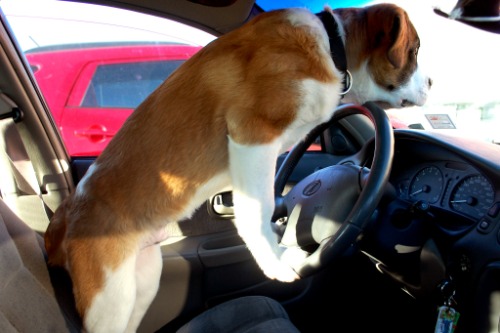1. Don’t Drive With an Unrestrained Dog – New Jersey

New Jersey has a law requiring that dogs be restrained while in a moving vehicle. While it might sound like a no-brainer, there’s an important safety concern here. Dogs jumping around in the car can distract the driver, cause accidents, or even injure themselves if there’s a sudden stop. The law is designed to keep both animals and people safe by preventing loose dogs from becoming a hazard while driving, according to 94.5 PST.
This rule applies to all vehicles, whether you’re driving in a compact car or an SUV, and the dog must be secured in a way that prevents them from interfering with driving. New Jersey isn’t the only state with this law—many others have similar regulations to make sure pets stay safe during car rides. For example, pet seat belts or car harnesses are great tools that help keep dogs safely in place while giving them enough room to enjoy the ride.
2. No Riding Camels on Highways – Nevada

In Nevada, it’s illegal to ride a camel on the highway, according to H&P Law. While camels aren’t a common sight in Nevada, this law likely harks back to the state’s historical connections with the U.S. Camel Corps, which experimented with camels for transportation in the 19th century. Though camel riding isn’t a frequent issue in modern Nevada, the law still stands and remains on the books as a quirky reminder of the past.
This rule has little practical effect today but is part of the historical legacy that shaped the state’s development. Nevada’s landscape and the historical use of camels for military purposes during the Civil War era have left behind a bizarrely specific road law. So, while camel rides are certainly rare on highways today, Nevada’s law remains as a piece of forgotten history that gets a chuckle when discovered.
3. Don’t Drive While Wearing Headphones – Rhode Island

In Rhode Island, driving while wearing headphones or earphones is illegal, according to The Rhode Island Department of Transportation. This one’s not as bizarre as it may sound; the law is actually in place to keep drivers aware of their surroundings, especially when it comes to hearing emergency vehicles or other important sounds while on the road. It makes sense—while you might enjoy blasting your favorite tunes, being fully immersed in music could cause you to miss a siren or the honk of a car horn trying to get your attention.
The rule applies to both the driver and passengers, and it is especially important in situations where quick reflexes could prevent accidents. Rhode Island isn’t alone in this; other states have similar laws or regulations that restrict the use of headphones while driving, citing safety concerns. So, while it may feel comfortable to block out the world with music during a long drive, make sure you keep one ear open to the sounds of the road.
4. No U-Turns on Main Street – California

California has a rather peculiar road rule that bans U-turns on any street that’s labeled “Main Street” in certain towns and cities across the state, according to the California DMV. While this might seem odd at first, the reasoning behind it is based on reducing traffic congestion in busy areas. The aim is to minimize dangerous traffic situations in high-traffic zones where making a U-turn might cause confusion or even accidents. In some places like San Francisco, where the streets are narrow and crowded, this law is particularly relevant to keep traffic flowing smoothly.
For those who love the flexibility of U-turns, this may come as a shock. But drivers who attempt to make U-turns in these designated areas face fines. Additionally, local officials have often updated signage to clearly mark areas where U-turns are prohibited, so it’s easy to avoid this mistake. It’s one of those rules that makes sense when you experience the crazy California traffic firsthand, where every small tweak to road regulations can have a big impact.
5. No Parking on Sidewalks – Kansas City, Missouri

While parking regulations are generally the same everywhere, Kansas City has a specific and somewhat quirky rule about parking, according to the city’s official site. It’s illegal to park on a sidewalk—yes, on the sidewalk itself! This rule might seem like a no-brainer, but you’d be surprised how many drivers park partially or completely on sidewalks, especially in crowded areas or in front of stores. The law is in place to ensure pedestrians can walk freely without obstacles and to avoid potential accidents caused by cars blocking walkways.
More importantly, this rule is particularly enforced in areas with high foot traffic, like downtown or near popular events, where it’s crucial that sidewalks remain clear for pedestrians. There’s also the matter of protecting the sidewalk infrastructure itself. Cars parked on the sidewalk can cause unnecessary wear and tear, forcing cities to spend more on repairs. So, the next time you’re in Kansas City, remember to keep those wheels off the sidewalks to avoid any fines and to respect pedestrian space.
6. Stop for School Buses at All Times – Nevada

Nevada is serious about the safety of children, and one of its road rules reflects that with a strict mandate: drivers must stop for school buses at all times when they have their stop sign extended, even if they’re on a multi-lane highway. This rule is a no-exception policy designed to keep children safe while they’re getting on and off the bus. It’s one of those rules that might seem straightforward but can be confusing to drivers unfamiliar with it.
The law is designed with safety in mind and comes with serious penalties for violators, including fines and points added to your driving record. The aim is to make sure that when a school bus is stopped, drivers remain alert and are willing to stop no matter what type of road they’re on. In Nevada, it’s common to see flashing lights and extended stop signs from school buses, and this law makes sure that kids are protected while boarding or disembarking. It’s one of those safety laws that everyone should be aware of, especially in school zones.
7. It’s Illegal to Drive With a Cold – Nevada

This rule in Nevada states that you can’t drive a vehicle if you are suffering from a cold or illness that impairs your ability to drive safely. While this might sound like a strange law, it actually exists to prevent accidents caused by drivers who are unfit to operate their vehicles due to illness. The law is designed to keep people safe from those who might drive while drowsy, distracted, or even feverish.
In practice, this law is difficult to enforce because it requires a determination of whether someone is too sick to drive. But it’s a good reminder to listen to your body. If you’re feeling under the weather, it might be better to avoid driving until you’re back to full health. Nevada wants drivers to be responsible and avoid putting themselves and others at risk simply because they refuse to take a sick day.
8. Watch for Pedestrians in Crosswalks – Oregon

In Oregon, it’s required by law to yield to pedestrians in crosswalks, but there’s a twist: the law mandates that pedestrians don’t have to wait for you to come to a complete stop, as long as they are already in the crosswalk. This law is intended to prioritize pedestrian safety in cities with heavy foot traffic, and it helps minimize accidents in busy urban areas. In many ways, it’s a push to encourage more walking and biking by giving pedestrians a little extra protection.
This rule is particularly relevant in cities like Portland, where foot traffic can be dense, especially in the downtown area. By making sure that cars yield to pedestrians at all times, the state is working to create a safer and more walkable environment for people of all ages. So, if you’re driving in Oregon, be extra careful when approaching crosswalks, and make sure to give pedestrians the right of way.
9. Don’t Drive Barefoot – Alabama

In Alabama, it’s technically illegal to drive barefoot. While there’s no official rule on the books that explains why this law exists, some experts believe it was put in place to ensure that drivers maintain control of the vehicle. Bare feet could potentially slip off the pedals or interfere with a driver’s ability to brake or accelerate properly, which could lead to accidents. It’s one of those odd but practical rules that seems weird at first but makes sense when you think about it.
Interestingly, the law isn’t always enforced unless there’s an accident or another issue with driving. However, some drivers might be surprised to find out that they can actually face a fine if they’re caught driving barefoot. Most people are surprised to hear that something so basic—driving without shoes—is against the law. So, the next time you’re heading out for a drive in Alabama, make sure to put on those shoes before hitting the road!
10. Don’t Stop on Railroad Tracks – North Carolina

In North Carolina, it’s illegal to stop your car on railroad tracks, even if you’re waiting for traffic to clear. This might seem like an obvious rule, but you’d be surprised how many drivers find themselves stuck on the tracks due to slow-moving traffic. The law exists to prevent accidents that could result in disastrous collisions between cars and trains. North Carolina takes railroad safety seriously, and penalties can be steep for drivers who fail to follow this rule.
The law also serves as a reminder that it’s always better to stay alert and avoid driving into an area where you might be trapped. If you’re on a track and cannot move forward, you’re not only risking your own safety, but you’re also impeding traffic and potentially putting others in danger. So, be mindful of your surroundings, especially when approaching railroad crossings.
11. No Driving After Dark Without Your Lights – Arkansas

In Arkansas, there’s a specific rule that requires all drivers to have their headlights on by dusk if they plan on driving at night. While this seems like standard procedure for most drivers, this law makes it an offense if you drive after dark without your headlights. The rule is especially important in areas where roads might not be well lit, ensuring that vehicles are visible to others and preventing accidents caused by poor visibility.
The law also emphasizes road safety in rural areas where streetlights may be few and far between. With drivers and pedestrians sharing the road, ensuring you have your lights on when visibility is low is essential to making sure everyone stays safe. So, if you’re driving through Arkansas during dusk or in the dark, remember to flick on those headlights.
12. No Rolling Stop at Stop Signs – Delaware

Delaware has a law that strictly prohibits rolling stops at stop signs. In many places across the U.S., drivers tend to slow down at stop signs but may not come to a complete stop, especially in rural areas with little traffic. However, in Delaware, the law requires that you make a full stop at all stop signs, even if there’s no one around. This law aims to ensure that drivers don’t inadvertently cause accidents by failing to stop at critical intersections.
The rule is heavily enforced, and police officers are known to issue tickets for even the slightest rolling stop. It may seem like a strict rule, but it’s intended to reduce accidents at intersections, especially in areas where road conditions may change quickly. So, in Delaware, always come to a full stop before proceeding.
13. Don’t Drive Over Gravel Roads Faster Than 25 MPH – Maine

In Maine, there’s a quirky law that prohibits drivers from speeding over gravel roads at more than 25 mph. Given the state’s rural areas, this rule is especially important for maintaining road safety. Gravel roads can be bumpy and unstable, and driving too fast can lead to accidents. The law encourages drivers to be cautious and control their speed when driving on these types of roads, ensuring that their vehicles stay on track and don’t cause damage to the road or surrounding environment.
This law is a reminder to drive responsibly, especially in less urbanized areas. It may feel tempting to speed through a long stretch of gravel road, but the state of Maine insists on keeping things slow to prevent unnecessary risks. So, take it easy on those gravel roads to avoid a fine or worse—an accident.
14. No Driving Without Your Driver’s License With You At All Times – Alabama

In Alabama, it’s actually illegal to drive without your driver’s license in your possession at all times. While this might sound like a common sense rule, there are a surprising number of people who forget to carry their licenses while driving. The law requires that if you are pulled over and cannot provide a valid driver’s license on the spot, you can be fined or even arrested. This rule has sparked debates over how much it truly prevents unsafe driving, but the intention is clear—ensure drivers are properly licensed and accountable. So, even if you’re just popping down the street, don’t forget that little plastic card!
Interestingly, the law also suggests that a driver should always have their car registration and proof of insurance with them while on the road. That’s probably less surprising, but it’s good to know that Alabama takes the enforcement of proper documentation seriously. This law is in place to make sure that drivers are abiding by the state’s rules, but it also serves to ensure public safety by verifying that drivers are properly licensed before they get behind the wheel.


